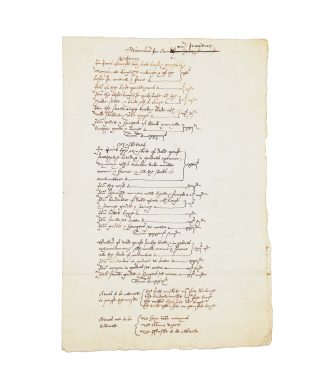HOWARD, Thomas
Warrant for Musters [and] Direccions for Armes and furniture
[manuscript on paper], [1605-1626].£950.00
Folio. Single folded sheet [41cm by 30cm], edges untrimmed, in modern docket. Manuscript in brown ink in secretary hand. Later addition of ‘and furniture’ in differing script to title. Pot watermark 1. ‘Warrants for ye musters’ written vertically on back of page 1. Very good copy. Minimal toning, wide margins. Three folds visible.
Warrant of the 1st Earl of Suffolk, Thomas Howard ordering a muster to be held at Wickham Market on the 14th-15th June. In listing format with charges for specific arms and equipment described, denoting ‘what was and was not deemed to be allowed’ as commanded by Thomas Howard himself. The former allowed for items including muskets.
Thomas Howard was appointed 5th Lord Lieutenant of Suffolk in 1605 having gained the favour of James I. Within this role he ordered the musters under discussion. This manuscript can be dated to the period during which he held this title – 1605-1626. Indeed, the pot watermark topped with a crescent below a trefoil and the letters ‘N B H’, has been used to date other documents and manuscripts to the years surrounding 1605. John Casson has connected paper with watermarks matching this one to the ownership of Henry Neville, specifically the Northumberland Manuscript, which possibly contained the first record of a play signed by William Shakespeare – the watermark being key to proposing Henry Neville as a Shakespeare authorship candidate. The watermarked paper used for this warrant was similarly used by Neville, Robert Cecil and Francis Bacon. Paper with a similar watermark, but not identical, was used for the will of Shakespeare himself (Casson, John. The Watermarks on the Northumberland Manuscript and Hand D: Research Findings and Reflections on the Shakespeare Authorship Question. eBLG, Article 11, 2018). Exclusive and expensive paper.
Musters were utilised periodically during this era as a means to gather and record the local population, specifically young militarily-able and armed men, during a time of civil unrest or war. Historical documents demonstrate the strict agenda for these musters, where a variety of different drills and positions were performed by these civic soldiers. The Jacobean Era can be defined by tumultuous political change, and perhaps the creation of the warrant was necessitated by the foiled 1605 Gunpowder Plot, which Thomas Howard himself had been involved in thwarting when he initially spotted the gunpowder in the cellar beneath Parliament. Pertinent to this is the requirement for ‘armes’ to be recorded, demonstrating how the plot led to civilian weapons and arms being tightly controlled and regulated in anticipation of conflict.
Thomas Howard’s power diminished rapidly after 1615, in part due to the consistently perilous state of his financial resources. The sheer extent of these debts as well as questionable conduct during his appointment as Lord High Treasurer in 1614 led to his arrest and imprisonment in 1619. Though he was later released, he lived a disgraced existence until his death in 1626; it is probable that the muster was created prior to these events.
In stock




